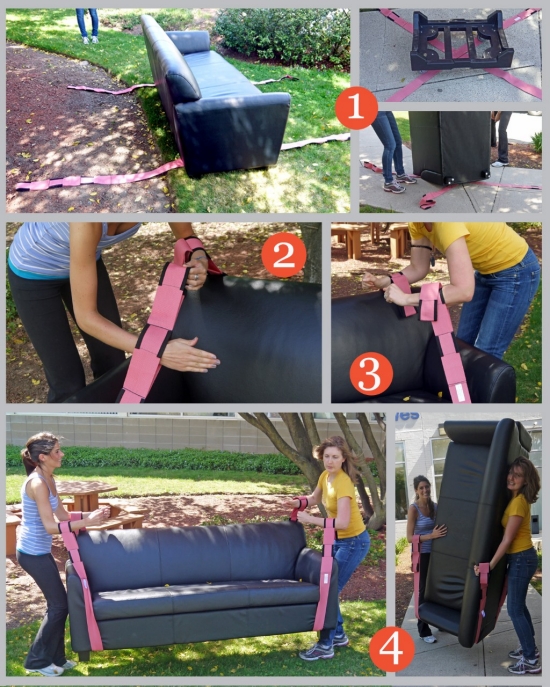You may not be a mover by profession, but that doesn’t mean you can’t use the same tools and methodology as the pros. For carrying heavy or bulky furniture with a partner, use moving straps. Moving straps are efficient moving tools that expedite the moving process. They also save wear-and-tear on your body. Sometimes called furniture lifting straps, the straps use your body’s strength and simple physics—leverage—to allow you to lift even heavy furniture with ease. Furniture moving straps lower the center of gravity of the item you’re lifting and allow you to maneuver it without excessive bending. There are two basic designs of moving straps: shoulder and forearm.
If you learn how to use furniture moving straps correctly, you will reduce your chance of injury and damage to your belongings. Here are 10 tips to use as preliminary guidelines:
- Read the instructions on your specific type of moving straps before trying to move anything.
- Make sure you have a clear path in which to move the item before attaching the straps. You will also need good visibility to know where you’re heading.
- Wear shoes that provide enough grip to avoid slipping.
- It may sound obvious, but be sure to measure doorways and staircases before you make the move.
- Place the straps either across your chest and shoulders or forearms. You and your partner can help each other attach the other ends of the straps.
- Lay the straps on the floor in front of what you are moving. With your buddy, tip the piece of furniture or appliance backward.
- Move the lifting straps under the object, centering them, but placing each one near the outside edge of the item.
- It is essential that you work in tandem with your partner. If you aren’t synchronized with your partner, it could cause injury from strain or you could drop the item.
- When you are ready to move, take small steps one of you moving backwards and the other forward.
- Again, working with your partner, bend your knees at the same time to lower the item to the floor when you have it in position. Keep your back straight to prevent strain.
- Place moving straps under object. For furniture with legs, place straps on either end running parallel to each other, and on the inner side of the legs. For lopsided objects, furniture without legs and moving dollies, place straps in an x-pattern for added stability.
- Choose the right arm loop. Forearm moving straps will have several arm loops to accommodate furniture and appliances of all sizes. Slide your hand through the arm loop that will make the moving straps the right length for lifting the object at least 5’’ off the ground.
- Assume the position. With arms bent and straps securely on your upper forearms, bend your knees and prepare to lift from your legs (this will help protect your back).
- Get moving! Carefully move in tandem with your partner, one of you walking backwards while the other faces forward. If you are moving a large object, small strides will make for the smoothest transport.

*Extra Tip: Don’t make the job harder than it has to be! When carrying a couch with forearm moving straps, it’s much easier to use the parallel strap alignment under the legs than the x-alignment with the couch on its side. Only transport couches vertically when necessary, such as when moving furniture around tight corners and up narrow staircases.
Instructions for Using Shoulder Moving StrapsShoulder moving straps are typically a little more expensive than forearm moving straps, but well worth the extra cost.
- Suit up. Position the harness moving straps over your shoulders, as pictured they should cross in the back, and the buckle should lay flat in front.
- Buckle up. The long strap should be laid out underneath the object you’re moving, running parallel. Attach one end to your harness, weaving it up and over the round bar.
- Have your partner do the same. The other end of the strap should be attached in the same manner to your partner’s harness.
- Adjust. You’ll want the length of the strap to be long enough to fit under the object and through both harnesses, but if it is too long, you won’t be able to lift anything off the ground. Bend down and adjust the length of strap woven through your harness’ buckle accordingly.
- Lift from your legs. With knees bent and hands positioned on the sides of the object for stability stand in tandem with your partner. You will be surprised at how easy it is to lift even heavy pieces of furniture!
- Get moving! Carefully move in tandem with your partner, with one of you walking backwards while the other faces forward. Use your hands to stabilize the object as you walk. If you are moving a large object, small strides will make for the smoothest transport.

*Never carry what you can roll. Hand trucks and moving dollies allow you to wheel stacks of moving boxes or large furniture items with ease.
Nancy LaFever
Subscribe to Reliable Van And Storage's Blog










Comments